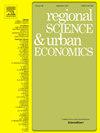受过大学教育的人的复杂性和位置:有点互补
IF 2.9
2区 经济学
Q1 ECONOMICS
引用次数: 0
摘要
Kremer(1993)提出,在具有复杂生产过程的企业中雇用的高技能工人之间的互补性会激励企业及其雇用的工人在地理上进行协同工作,但迄今为止,实证工作主要集中在企业和行业层面上的互补性。本文利用1960年至2020年561个城市的人口普查和美国社区调查数据,为城市及城市以下受过大学教育的工人之间的高技能互补性提供了新的证据。研究发现:(1)越复杂的职业和行业,大学生比例越高;(2)高校总体比例较高的城市在某一行业或职业中高校比例较高;(3)越复杂的行业和职业,高校份额相对于城市高校份额的梯度越大;(4)大学比例较高的城市往往容纳了更复杂的行业和职业组合;(5)在城市层级以下,(a)高校在某一行业的份额越高,上下游行业的高校份额越高;(b)大学在某一职业中所占比例越高,该职业在该行业的其他职业中所占比例越高;(6)越复杂的行业和职业呈现出更大的(副城市)梯度。最后,对大学工资的分析支持了生产率相关因素在起作用的假设。本文章由计算机程序翻译,如有差异,请以英文原文为准。
Complexity and colocation of the college-educated: Sort of complements
Kremer (1993) proposed that complementarity between highly skilled workers who are employed in firms with complex production processes would motivate both the firms and the workers they employ to colocate geographically, but thus far empirical work has focused on complementarity at the firm and industry level. This paper uses Census and American Community Survey data between 1960 and 2020 on 561 cities to present new evidence on high-skill complementarity among college-educated workers at and below the city level. The findings include: (1) More complex occupations and industries employ higher college shares; (2) Cities with higher overall college shares employ higher college shares within an industry or occupation; (3) More complex industries and occupations tend to exhibit larger gradients of college share with respect to city college share; (4) Cities with higher college shares tend to house more complex mixes of industries and occupations; (5) Below the city level, (a) college share in an industry tends to be higher, the higher the college share in industries up- and downstream; (b) college share in an occupation tends to be higher, the higher the college share in the remainder of the industry; and (6) More complex industries and occupations tend to exhibit larger (sub-city) gradients. Finally, analysis of college wages supports the hypothesis that productivity-related factors are at work.
求助全文
通过发布文献求助,成功后即可免费获取论文全文。
去求助
来源期刊

Regional Science and Urban Economics
Multiple-
CiteScore
5.30
自引率
9.70%
发文量
63
期刊介绍:
Regional Science and Urban Economics facilitates and encourages high-quality scholarship on important issues in regional and urban economics. It publishes significant contributions that are theoretical or empirical, positive or normative. It solicits original papers with a spatial dimension that can be of interest to economists. Empirical papers studying causal mechanisms are expected to propose a convincing identification strategy.
 求助内容:
求助内容: 应助结果提醒方式:
应助结果提醒方式:


